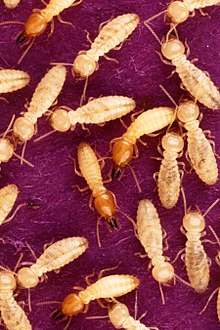White ants
| Termite Temporal range: 251–0 Ma Late Permian – Recent |
|
|---|---|
 |
|
|
Formosan subterranean termite (Coptotermes formosanus) Soldiers (red-coloured heads) Workers (pale-coloured heads) |
|
| Scientific classification | |
| Kingdom: | Animalia |
| Phylum: | Arthropoda |
| Class: | Insecta |
| Order: | Blattodea |
| Infraorder: | Isoptera |
| Families | |
|
Cratomastotermitidae |
|
Cratomastotermitidae
Mastotermitidae
Termopsidae
Archotermopsidae
Hodotermitidae
Stolotermitidae
Kalotermitidae
Archeorhinotermitidae
Stylotermitidae
Rhinotermitidae
Serritermitidae
Termitidae
Termites are eusocial insects that are classified at the taxonomic rank of infraorder Isoptera, or as epifamily Termitoidae within the cockroach order Blattodea. Termites were once classified in a separate order from cockroaches, but recent phylogenetic studies indicate that they evolved from close ancestors of cockroaches during the Jurassic or Triassic. However, the first termites possibly emerged during the Permian or even the Carboniferous. About 3,106 species are currently described, with a few hundred more left to be described. Although these insects are often called white ants, they are not ants.
Like ants and some bees and wasps from the separate order Hymenoptera, termites divide labour among castes consisting of sterile male and female "workers" and "soldiers". All colonies have fertile males called "kings" and one or more fertile females called "queens". Termites mostly feed on dead plant material and cellulose, generally in the form of wood, leaf litter, soil, or animal dung. Termites are major detritivores, particularly in the subtropical and tropical regions, and their recycling of wood and plant matter is of considerable ecological importance.
...
Wikipedia
